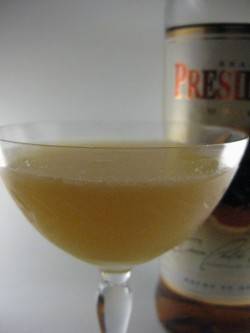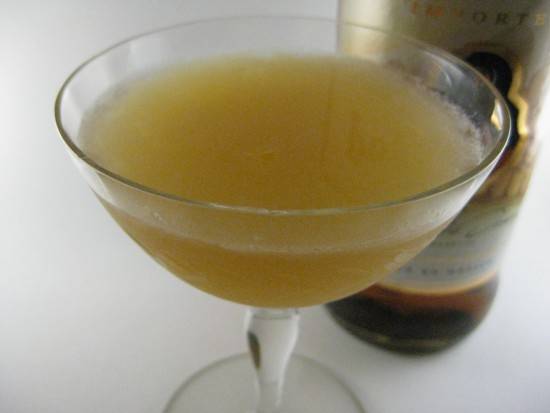 Since this won’t be nearly as clever without doing so, let me be gender-normative for just a moment. Sometimes, you need to have a cocktail in your repertoire that, as they say in deodorant commercials, is strong enough for a man but gentle enough for a woman. Whether you actually subscribe to annoyingly ubiquitous stereotypes or you just like a bit of gender-bending, The Sidecar, suave, sophisticated, and a little complicated, is for you. Whenever I have friends that don’t like liquor all that much but want to start drinking cocktails, the Sidecar is one of the first that comes to mind. The combination of lemon juice, orange liqueur, and brandy is at once extremely cocktail-y and approachable. In fact, it’s the drink I recommended to a friend panicked over the right cocktail to order for drinks with Ira Glass, of This American Life fame. What else do you need?
Since this won’t be nearly as clever without doing so, let me be gender-normative for just a moment. Sometimes, you need to have a cocktail in your repertoire that, as they say in deodorant commercials, is strong enough for a man but gentle enough for a woman. Whether you actually subscribe to annoyingly ubiquitous stereotypes or you just like a bit of gender-bending, The Sidecar, suave, sophisticated, and a little complicated, is for you. Whenever I have friends that don’t like liquor all that much but want to start drinking cocktails, the Sidecar is one of the first that comes to mind. The combination of lemon juice, orange liqueur, and brandy is at once extremely cocktail-y and approachable. In fact, it’s the drink I recommended to a friend panicked over the right cocktail to order for drinks with Ira Glass, of This American Life fame. What else do you need?
The Sidecar, like the Margarita, belongs to the daisy family of drinks, which I talked about a little in my last column. As Frederic of The Cocktail Virgin Slut pointed out, I had oversimplified the category earlier. Daisies are, more generally, a base liquor, a sour citrus juice (lemon or lime, although I bet you could make a fantastic daisy-variant with yuzu or calamansi juice), and a sweetener other than plain sugar. In fact, you can take the following recipe and substitute yellow Chartreuse for the orange liqueur to get a deliciously herbal Brandy Daisy.
There’s really no excuse for your bartender not knowing how to make a Sidecar — at least, if it’s the type of bar that uses fresh-squeezed juice — dives, as usual, are excepted (or at least excused) from these sweeping proclamations. It’s a World War I recipe (at least, according to the lore), and it can be made decently with a 1-1-1 ratio of ingredients, so it’s not hard to remember. Luckily, this makes it easy to refresh the memory of even the least-knowledgeable bartender.
While the 1-1-1 ratio for this drink is a perfectly serviceable cocktail, I prefer a 2-1-1 mix, letting the brandy lead. This is especially true if you’re mixing with a decent cognac, which will lend a sophisticated dryness to the cocktail. If you don’t have mixing cognac, however, this drink can be made happily with Spanish brandy (affordable, quite sweet and rich), Armagnac (the other great French brandy, sweeter and funkier than cognac), or even Calvados (French apple brandy) or American apple brandy (avoid applejack, which is technically a blend of neutral spirits and apple brandy – much less appealing). Heck, make a Sidecar with a decent rum, if you want (this is sometimes called a Cablecar). You can even go so far as to sub in gin, which makes a White Lady or Delilah, but this drink, while equally delicious, is so different that I hesitate to call it a variation (do try it sometime, please —it’s perfect on a warm day).

The Sidecar
- 1 1/2 oz brandy
- 3/4 oz lemon juice
- 3/4 oz Cointreau or other orange liqueur
Combine all ingredients in a shaker with ice. Shake until very cold, and strain into a cocktail glass. Garnish with a thin orange wheel or wedge, if you feel like it.
The garnish in this case is purely for visual appeal.
The history of the Sidecar is somewhat shrouded in mystery. While, as I mentioned earlier, it clearly belongs to the daisy family of drinks, it appears to be of somewhat later pedigree: the first appearance of the cocktail in print was in 1922, and various famous bartenders – including Paul Vermiere, Harry MacElhone, and Pat MacGarry – have claimed or been given credit for its creation. David Embury, the most opinionated amateur cocktail enthusiast of the mid-twentieth century, offers a charming story involving an officer, his favorite tipple, and the motorcycle in which he was driven to the club where it was made. Like most overly convenient origins, this is probably not to be taken too seriously. Whatever story you choose to believe will still result in a delicious drink, and I think we can all be satisfied with that.








